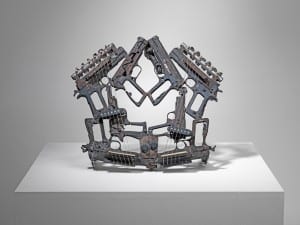Transmitting Andy Warhol is a dazzling exhibition which enables the viewer to discover more about the Pop Art pioneer and founder of the influential Studio 54 movement, whose radical designs transformed the modern art world.
Warhol used the worlds of fashion and media to create a new, accessible kind of art which used imagery that appeared in advertisements and TV as the basis for much of his work. One of the artist’s unforgettable phrases was his view that ‘everyone should have their fifteen minutes of fame’. It would have been interesting to see how he would have responded to today’s celebrity obsessed culture, with its emphasis on reality TV shows featuring every detail of celebrities’ private lives. The exhibition at the Tate Liverpool succeeds in showing how Warhol made art less elitist by challenging traditional ideas of art.
His critical role as one of the key commentators on the pop culture of the 1960’s and 1970’s was firmly established after his early collaboration with groundbreaking band the Velvet Underground. One of the exhibition’s highlights is the presentation of the travelling multi-media spectacle The Exploding Plastic Inevitable (EPI), which highlights the journey of this hip New York band. Highly original and dramatic, the Exploding Plastic Inevitable (EPI) follows the band’s journey around the U.S. and showcases the contribution of influential musicians such as Lou Reed and John Cale. The exhibition shows how the Exploding Plastic Inevitable (EPI) toured the U.S. with its framework used as a backdrop for the band’s US tour.
Television commercials and many of the artist’s fashion illustrations for Vogue and Harper’s Bazaar are also on display as well as well known works such as Three Brillo Soap Pad Boxes (1964/68) and Campbell’s Soup I (1968). Another key method of Warhol’s was to use mass produced silkscreen paintings of celebrity figures, and the viewer will be able to see this method used in the striking Marilyn Diptych. The effect is similar to that of looking at stills from one of Marilyn’s films or photographs from the cutting room floor. By creating the Marilyn Diptych, Warhol used a new and modern equivalent of the ‘formal’ portraits of famous icons, with a colourful image on silk replacing the framed paintings of earlier years.
Warhol’s influence has led to many artists being inspired by his use of mass media to create an exciting new style of modern art. Transmitting Andy Warhol is exhibited alongside Gretchen Bender – an exhibition which features the work of American multimedia artist Gretchen Bender (1951–2004). Gretchen Bender presents the first solo exhibition of the artist’s work in the UK to date and showcases a selection of her multimedia installations, which provide a cynical commentary on the pervasive role of the media in society. Total Recall is the highlight of the Gretchen Bender exhibition, with its flickering TV screens portraying TV and news images. The viewer feels as if they are being bombarded with a variety of diverse media images during this display. The overall effect is to unsettle the viewer and make them aware of how critical the role of the media is in shaping our thoughts and beliefs.
Transmitting Andy Warhol is a must see for all modern art enthusiasts, bringing the world of the New York art scene of the 1960s and 1970s to life.
Bryony Lanham
Transmitting Andy Warhol, until 8 February 2015, Tate Liverpool. For more information visit www.tate.org.uk.
Follow us on Twitter @AestheticaMag for the latest news in contemporary art and culture.
Credits
1. Andy Warhol, [no title] 1971. © 2014 The Andy Warhol Foundation for the Visual Arts, Inc. / Artists Rights Society (ARS), New York and DACS, London





